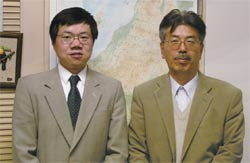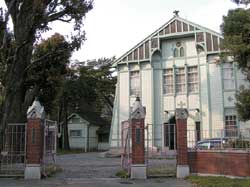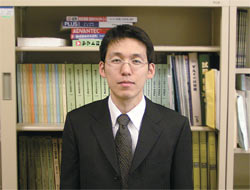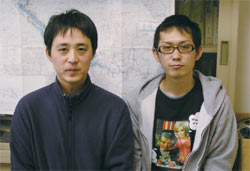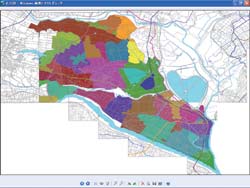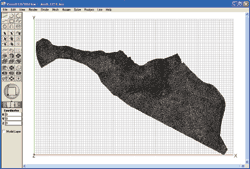Shifting from "University (Faculty)"-centered Organization to "Graduate School"
-centered One, with Higher Needs, as well as Vigorously Promoting Works that Contribute to Regional Revitalization
This issue focuses on Gunma University, a national university corporation in Gunma Prefecture. Under the National School Establishment Law, it was founded in 1949 as a new system university with three faculties of Education, Medicine, and Engineering, integrating several old-system schools. Then, through organizational changes and enhancement, 4 faculties are now established: Faculties of Education, Social and Information Studies, Medicine, and Engineering. The University also has incorporated Graduate Schools of Education, Social and Information Studies, Medical Sciences, and Engineering. Due to such circumstances, the campuses are located in three different places: Aramaki area, Showa area (both in Maebashi city), and Kiryu area (in Kiryu city). This interview focuses on "Dept.of Civil and Environmental Engineering, Graduate School of Engineering, Gunma University," which is based in Kiryu area.
The Department has developed analytical theory that forms a core of "UC-1 Geotechnical Analysis series" of Forum8, as well as various solvers that express it, with Professor Keizo Ugai as a leading member, who is also the Vice Dean of the Graduate School of Engineering. On the other hand, multiple laboratories within the Department have introduced Forum8's "UC-win/Road," "Geotechnical Finite element Elastoplastic Analysis Software (GeoFEAS)," "Dynamic effective stress analysis for ground (UWLC)," "3D seepage analysis (VGFlow)," "UC-win/WCOMD," and so on as users. To hear their views in utilizing these software products actually in studies and lectures of the Dept., we interviewed 5 people: Dr. Keizo Ugai and Dr. Fei CAI, Assistant Professor from Geotechnical Engineering Laboratory, Dr. Kensaku Matsumoto, Assistant Professor and a graduate student Shunichi Haishima from Basin Environment Laboratory, and Dr. Kenichiro Nakarai, Associate Professor from Concrete Laboratory.
With the progress of science and technology or change of the role of a university in a society as a background, Gunma University carried out a substantial restructure of its conventional organization this spring. Its goals are (1) to form a base for original research that leads the world, (2) to develop human resources capable of leading state-of-the-art science and technology, and getting actively involved in international communities, (3) to conduct social contributions based on regional cooperation, joint collaboration of academy, industry, and government, and international exchange. In fact, from some time before, especially in the Faculty of Engineering, it became more and more conspicuous that lots of students go on to Graduate School. In recent years, the share of such students reached over 60 %. For this reason, it was required to bring a shift to a system that presupposes the needs for higher education and study. Therefore, the former structure with university (Faculties) as a center was reorganized into the one based on Graduate Schools from April 2007.
At the same time, the former "Department of Civil engineering" was reorganized into "Dept. of Civil and Environmental Engineering" under the new system. It is intended to include in a research area not only "construction" by which it means simply building a structure with material, but also items such as how a structure should be or what kind of mechanism it should have, or urban planning and disaster prevention, along with the environment that surrounds them. About this, Professor Keizo Ugai thinks that the actual condition of research is changing with the times, and that the alteration of names is a result of responding to such a trend.
In addition, the post of "Vice Dean of the Faculty of Engineering" that Prof. Ugai himself had been taking up was succeeded to as "Vice Dean of the Graduate School of Engineering." The name of "Vice Dean of the Faculty of Engineering" is now used for a separate post responsible for special assignment including entrance examination. Other than this, according to a partial amendment of the School Education Law (enforced on April 1, 2007), "Assistant Professor" was changed into "Associate Professor," which lays more weight on researches. At the same time, a new post of "Assistant Professor" was established to be engaged in both research and education, as a result of separating from "Research Associate," a post for supporting professors and conducting works necessary in operating the organization to which he or she belongs.
Professor Keizo Ugai of a "Geotechnical Engineering Laboratory" specializes in landslide, and currently focusing on researches including landslide that occurs in the event of an earthquake. This was led by the Niigata Chuetsu earthquake, which occurred in 2004. Following large-scale and a large number of landslides that occured in the mountain areas at an unprecedented level as far as he knows, disaster investigation got started. Since then, the mechanism of the slope failure associated with an earthquake, which had not been fully studied till then, was made mostly clear. He is planning to systematize it and present the detail on a full scale in the future.
On the other hand, Dr. Fei CAI is making a research in landslide prevention works, liquefaction, and seepage flow analysis etc., based on numerical analysis of the ground.
As mentioned above, the Laboratory with Prof. Keizo Ugai, Assistant Prof. Fei CAI, and Associate Prof. Akihiko Wakai developed solvers that are used as engines for "UWLC," "3-D slope stability analysis (LEM)," "VGFlow," and "GeoFEAS," all forming "UC-1 Geotechnical Analysis Series," based on the result of their research in relation to the application of FEM (finite element method) to foundation analysis. Forum8 has added pre- and post- parts to manufacture products, and been providing them. Assistant Prof. Fei CAI utilizes them positively in his own study, for their functions as tools was improved. He is especially paying attention to "GeoFEAS," which not only serves multiple uses but also is easy to operate by following the manual.
Moreover, in the "Basin Environmental Laboratory," the problems about disaster prevention or environment have been studied in the areas of Hydrology with Prof. Shigeki Kobatake as a leader, or River Engineering with Associate Prof. Yoshihiko Shimizu. Assistant Prof. Kensaku Matsumoto takes up an approach to apply full use of GIS (geographic information system) or numerical simulation technique in such a process, aiming to develop a health monitoring system of a riverbank etc. To build up its base, the Lab is also aiming at providing with environment where students can handle various computer languages, such as FORTRAN, C++, Java, BVA, and HTML.
Mr. Haishima, who has actually been engaged in creating non-structural grids with "VGFlow" appreciates its tool functions to edit the number of nodes freely etc., in analyzing flood. He mentions a need for further improvement of efficiency, though. On the other hand, the output of the analysis result is visualized in two dimensions on GIS at present. From a viewpoint of wishing to express it in a three dimensions, Dr. Kensaku Matsumoto expects its linking function with "UC-win/Road."
Furthermore, the "Concrete Laboratory" is conducting researches on the material, construction, structures, etc. of concrete, putting emphasis on experiments and numerical-analysis approaches. One of the subjects currently regarded as big pillars in this laboratory is a performance assessment of expanded concrete (chemical pre stress concrete). About this, Prof. Yukikazu Tsuji has been leading a work that should also serve as a finish of the efforts over 30 years and more. Moreover, as a subject relating to numerical analysis, Dr. Kenichiro Nakarai has been working hard in research on extra-long durability of concrete structures and its promotional experiment with Prof. Yukikazu Tsuji in relation to geological isolation of radioactive wastes. He says, "Especially when it comes to the subject involved with 10 thousands of years like treatment of radioactive wastes, an approach with numerical analysis simulation is indispensable."
Under such circumstances, "UC-win/WCOMD" has been used or tried in various experiments and examination. The program used as its engine was developed by the Concrete Laboratory of Tokyo University, to which Dr. Kenichiro Nakarai belonged till August last year. He took part in its developing process. Though his use is now limited to the pre-processor of "UC-win/WCOMD," he evaluates it as "very easy to use." Partially because he is very familiar with the performance of the original program itself, he utilizes the tool as a single unit to support students to check before conducting an experiment, or to understand the phenomena after the experiment. "Since its pre- processor is robust, I think it is user-friendly as an educational tool."
In parallel with the above mentioned tasks they have been coping with till now, Professor Keizo Ugai is grappling with the spread of "Flower Fence" as a new area of research with actualization of cooperation among academy, industry, and government in mind, as well as regional revitalization with it. To make a flower fence, burnable soil made of cryptomeria bark produced in the Gunma Prefecture is shaped into a mat of 25cm by 25cm, 4cm thick ("Flower Mat"). Each mat is put in a basket, which will be installed with a special lattice to form a fence to be decorated with fresh flowers. "Based on the idea developed with Tokyo Metropolis as the central member as part of advancement projects promoted by the Ministry of Agriculture, Forestry and Fisheries, we have been aiming to realize the idea as early as possible."
For this, local industries within the Prefecture have been cooperating for all the works including soil development, repeating one trial and error after another. The first sample was created in January this year. Reflecting the challenges that arose from it, "Exhibition of Wall Art of Flowers," which connects the fences for 30m long, was opened to the public for the first time at "Earth Day in Kiryu" (held on April 21) sponsored by the Graduate School of the University. He expresses his wish to make it appealing nationwide by expanding the scale at "the 25th National Urban Greening Fair in Gunma," scheduled from March through June in 2008.
"How will it appear, by displaying what kind of flowers in what way, in the city area used as the exhibition site?" It was Prof. Ugai's aim to simulate each case in advance, when he decided to adopt "UC-win/Road." Although there were considerable restrictions in preparation for this occasion, he says that they became confident of data creation with 3D-VR (virtual reality) and CG (computer graphics), and actually felt how effective they were.
Prof. Keizo Ugai points out that as IT (information technology) gets advanced and widespread, it is becoming more capable of applying to many different things. In addition, he expects its potentiality in practical use.
"It is all the more necessary to keep in mind that we should always compare with actual events and proceed researches while examining whether the adopted method is appropriate or not."
We are most grateful to everyone involved for spending time with us for the interview.
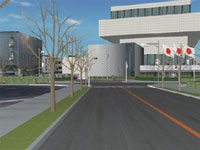 |
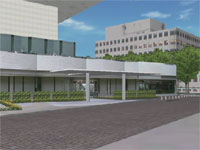 |
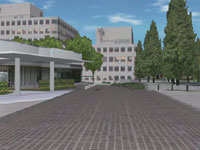 |
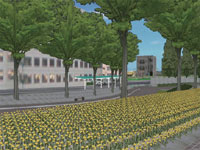 |
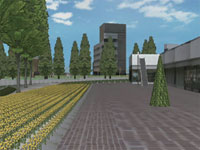 |
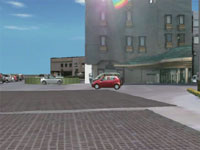 |
|||
